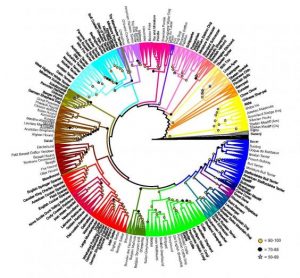
Geneticists grouped different dogs together based on how closely they are related. Source: NIH Dog Genome Project.
Ian Johnston | April 28, 2017 | Independent
from The Genetics Literacy Project
An evolutionary tree of more than 161 dog breeds has been mapped out by geneticists, showing which types are closely related to each other.
The research will be of obvious interest to dog owners but it is hoped it will shed light on the causes of diseases that affect both dogs and humans, including cancer.
…
Dr Heidi Parker, a dog geneticist at the US National Institutes of Health (NIH), said: “People were using dogs as workers thousands of years ago, not just hundreds of years ago.”
…
The prevalence of diseases [like epilepsy, diabetes, and cancer] varies significantly between dogs, which could help find genes with protective or harmful effects.
“Using all this data, you can follow the migration of disease alleles and predict where they are likely to pop up next, and that’s just so empowering for our field because a dog is such a great model for many human diseases,” said Dr Elaine Ostrander, who researches the genetics of cancer at the NIH.
“Every time there’s a disease gene found in dogs it turns out to be important in people, too.”
[Read the original source here]








